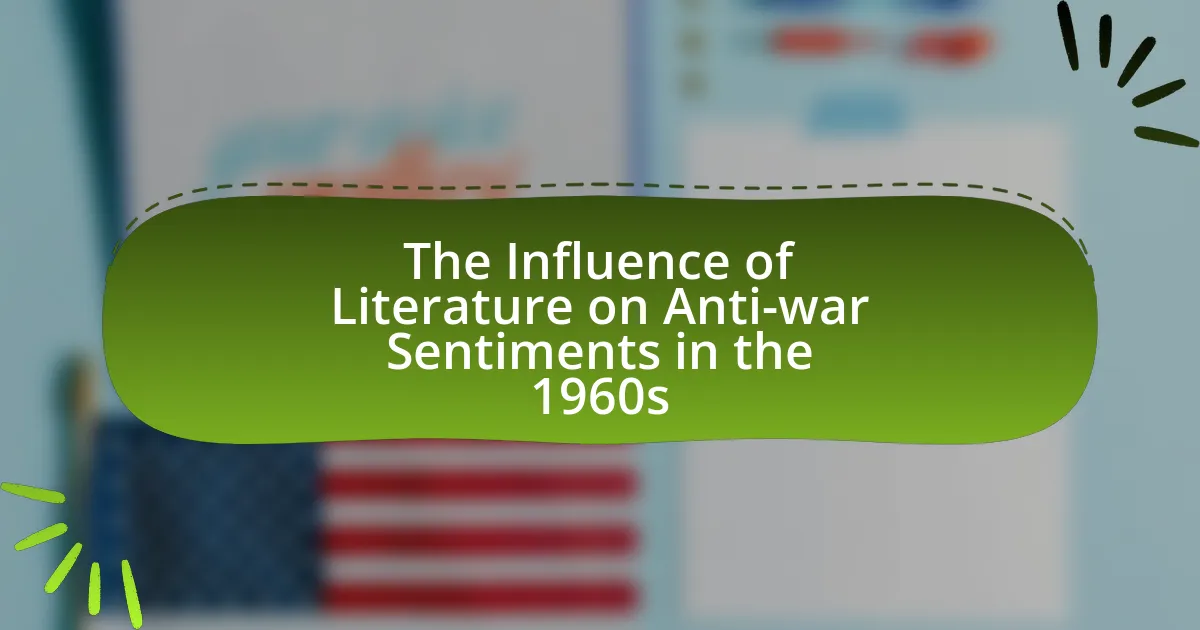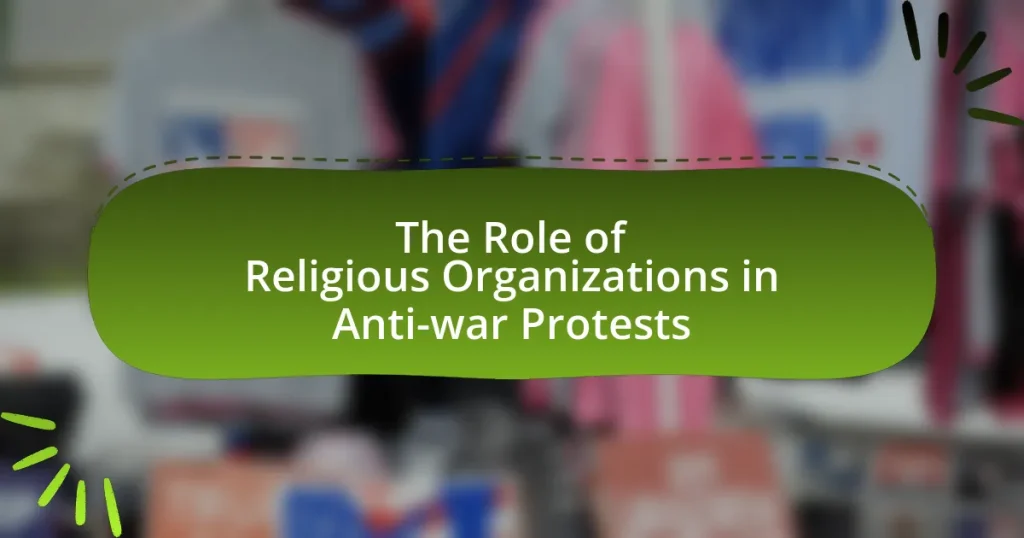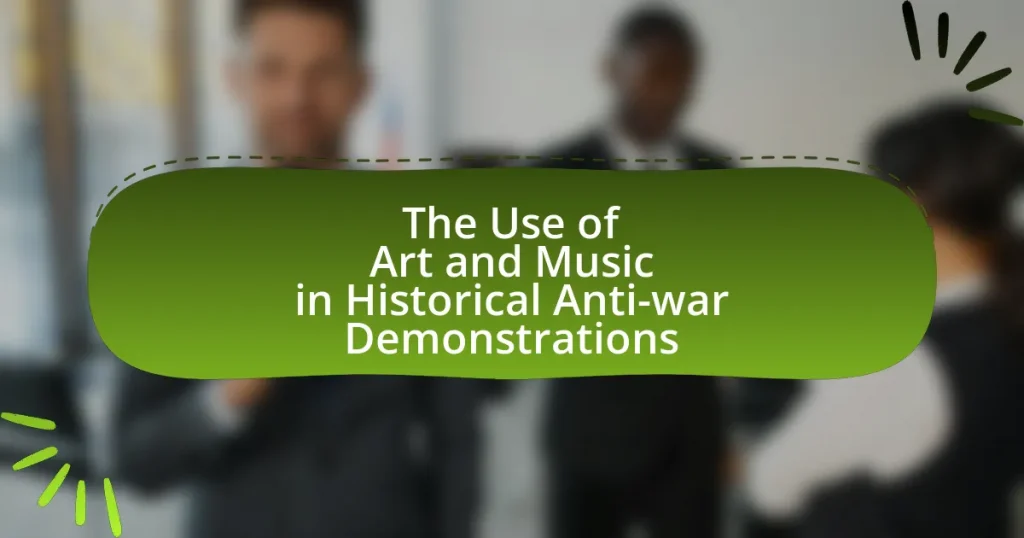The article examines the significant influence of literature on anti-war sentiments during the 1960s, particularly in relation to the Vietnam War. It highlights key literary works, such as Kurt Vonnegut’s “Slaughterhouse-Five” and Joseph Heller’s “Catch-22,” which critiqued the absurdity and moral implications of war, resonating with a disillusioned generation. The article discusses prevalent themes in anti-war literature, the role of authors in challenging war narratives, and the impact of accessible literature on public perception. Additionally, it explores the intersection of anti-war literature with social movements, the influence of media coverage, and the lessons contemporary writers can draw from this historical context to address current conflicts.
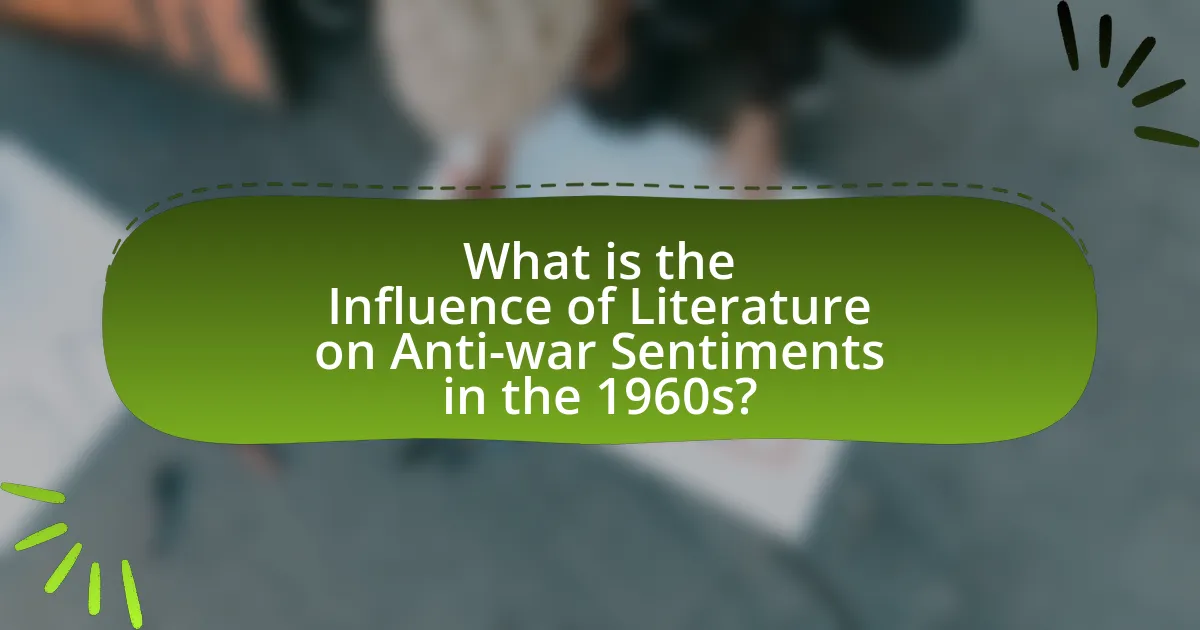
What is the Influence of Literature on Anti-war Sentiments in the 1960s?
Literature significantly influenced anti-war sentiments in the 1960s by shaping public perception and fostering critical discourse about the Vietnam War. Prominent works, such as Kurt Vonnegut’s “Slaughterhouse-Five” and Joseph Heller’s “Catch-22,” highlighted the absurdity and moral implications of war, resonating with a generation increasingly disillusioned by government narratives. These literary pieces not only provided a platform for dissent but also mobilized readers to question the ethics of military engagement, contributing to the broader anti-war movement. The impact of literature during this period is evidenced by its role in protests and discussions, as well as its ability to articulate the emotional and psychological toll of war on individuals and society.
How did literature reflect the anti-war sentiments of the 1960s?
Literature in the 1960s reflected anti-war sentiments through powerful narratives that critiqued military conflict, particularly the Vietnam War. Prominent works, such as Kurt Vonnegut’s “Slaughterhouse-Five” and Joseph Heller’s “Catch-22,” illustrated the absurdity and brutality of war, resonating with a generation disillusioned by government policies. These texts employed satire and surrealism to convey the emotional and psychological toll of warfare, effectively mobilizing public opinion against the Vietnam War. The widespread publication of poetry, essays, and novels during this era served as a platform for voices advocating peace, highlighting the moral implications of war and fostering a cultural movement that questioned authority and sought social change.
What themes were prevalent in anti-war literature during this period?
Prevalent themes in anti-war literature during the 1960s included the futility of war, the dehumanization of soldiers, and the moral implications of violence. These themes were often illustrated through vivid imagery and personal narratives that highlighted the psychological and physical toll of conflict. For instance, works like Kurt Vonnegut’s “Slaughterhouse-Five” depicted the absurdity of war and its impact on human life, while Tim O’Brien’s “The Things They Carried” explored the burdens carried by soldiers, emphasizing their emotional struggles and the moral dilemmas faced in combat. Such literature served to challenge the glorification of war and fostered a critical perspective on military engagement, resonating with the growing anti-war movement of the time.
How did authors use their works to challenge the war narrative?
Authors used their works to challenge the war narrative by depicting the harsh realities and moral ambiguities of conflict, thereby questioning the justifications for war. For instance, novels like “Slaughterhouse-Five” by Kurt Vonnegut illustrated the absurdity of war through a nonlinear narrative and the protagonist’s traumatic experiences, effectively critiquing the glorification of military action. Similarly, Tim O’Brien’s “The Things They Carried” blended fiction and memoir to convey the emotional burdens faced by soldiers, emphasizing the psychological toll of war rather than its heroism. These literary approaches not only provided a counter-narrative to official war propaganda but also resonated with the growing anti-war sentiments of the 1960s, influencing public perception and discourse around military engagement.
Why was literature a powerful tool for anti-war movements in the 1960s?
Literature was a powerful tool for anti-war movements in the 1960s because it effectively conveyed the emotional and moral complexities of war, influencing public opinion and mobilizing activism. Prominent works, such as Kurt Vonnegut’s “Slaughterhouse-Five” and Tim O’Brien’s “The Things They Carried,” depicted the horrors of war and the psychological toll on soldiers, resonating with readers and fostering empathy. Additionally, poetry and essays from figures like Allen Ginsberg and Norman Mailer challenged the justifications for conflict, encouraging critical discourse and dissent against government policies. The widespread distribution of these literary works through various media amplified their impact, making literature a crucial element in shaping anti-war sentiments during this era.
What role did literary figures play in shaping public opinion against the war?
Literary figures played a crucial role in shaping public opinion against the war by using their works to critique military actions and highlight the human cost of conflict. Authors such as Kurt Vonnegut, in “Slaughterhouse-Five,” illustrated the absurdity of war and its devastating effects on individuals, which resonated with readers and fostered anti-war sentiments. Similarly, poets like Allen Ginsberg and writers like Norman Mailer used their platforms to express dissent and mobilize public consciousness against the Vietnam War, contributing to a broader cultural movement that questioned government narratives and military engagement. Their influential writings not only reflected societal discontent but also galvanized public protests and discussions, ultimately impacting policy and public perception regarding the war.
How did the accessibility of literature influence its impact on anti-war sentiments?
The accessibility of literature significantly amplified its impact on anti-war sentiments by allowing a broader audience to engage with critical perspectives on war. During the 1960s, the proliferation of paperbacks, magazines, and independent publications made anti-war literature widely available, reaching diverse demographics beyond the elite. For instance, works like Kurt Vonnegut’s “Slaughterhouse-Five” and Howard Zinn’s “A People’s History of the United States” became accessible to the general public, fostering a collective consciousness that questioned the morality and rationale behind military conflicts. This widespread distribution facilitated grassroots movements and discussions, ultimately contributing to a cultural shift against the Vietnam War, as evidenced by the significant protests and public demonstrations that drew inspiration from these literary works.
What genres of literature were most influential in promoting anti-war sentiments?
The genres of literature most influential in promoting anti-war sentiments include novels, poetry, and essays. Novels such as “Slaughterhouse-Five” by Kurt Vonnegut and “Catch-22” by Joseph Heller vividly depicted the absurdities and horrors of war, resonating with readers and fostering anti-war feelings. Poetry, particularly works by poets like Allen Ginsberg and W. H. Auden, expressed deep emotional responses to the devastation of war, further galvanizing public sentiment against military conflict. Essays and non-fiction works, including those by authors like Norman Mailer and Howard Zinn, provided critical analyses of war policies and their impacts, contributing to a broader understanding of the anti-war movement. These genres collectively shaped public discourse and mobilized opposition to war during the 1960s.
How did poetry contribute to the anti-war movement in the 1960s?
Poetry significantly contributed to the anti-war movement in the 1960s by articulating the emotional and moral objections to the Vietnam War. Poets like Allen Ginsberg and Sylvia Plath used their works to express dissent, evoke empathy, and challenge the prevailing narratives surrounding war. For instance, Ginsberg’s poem “Howl” criticized societal complacency and the dehumanizing effects of war, resonating with a generation disillusioned by violence and government policies. This literary expression galvanized public sentiment, fostering a sense of solidarity among anti-war activists and amplifying their calls for peace. The widespread dissemination of such poetry through readings and publications further solidified its role as a catalyst for social change during this tumultuous period.
What impact did novels and essays have on public perception of the war?
Novels and essays significantly shaped public perception of the war by humanizing the experiences of soldiers and civilians, thereby fostering anti-war sentiments. Works such as “Slaughterhouse-Five” by Kurt Vonnegut and “The Things They Carried” by Tim O’Brien depicted the brutal realities of war, challenging glorified narratives and exposing the psychological trauma faced by veterans. These literary pieces resonated with readers, leading to increased skepticism about government narratives and military actions. The widespread distribution of these texts during the 1960s coincided with growing protests against the Vietnam War, illustrating how literature served as a catalyst for social change and public dissent.
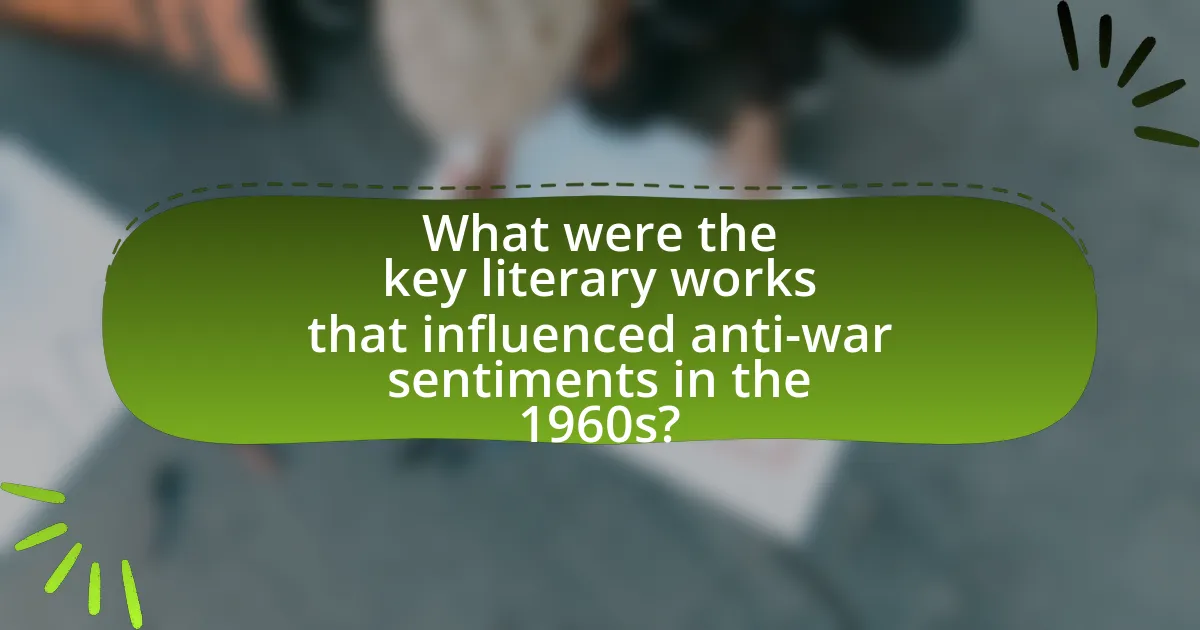
What were the key literary works that influenced anti-war sentiments in the 1960s?
Key literary works that influenced anti-war sentiments in the 1960s include “Slaughterhouse-Five” by Kurt Vonnegut, “The Things They Carried” by Tim O’Brien, and “Catch-22” by Joseph Heller. “Slaughterhouse-Five,” published in 1969, critiques the absurdity of war through the lens of a soldier’s experiences in World War II and the bombing of Dresden, highlighting the destructiveness of conflict. “The Things They Carried,” released in 1990 but rooted in the 1960s Vietnam War context, explores the emotional burdens of soldiers, emphasizing the psychological toll of warfare. “Catch-22,” published in 1961, satirizes the bureaucratic nature of war and the paradoxes faced by soldiers, illustrating the illogical and often cruel realities of military life. These works collectively shaped public perception and discourse around war, contributing significantly to the anti-war movement of the era.
Which authors emerged as prominent voices against the war?
Prominent voices against the war in the 1960s included authors such as Kurt Vonnegut, Joseph Heller, and Norman Mailer. Kurt Vonnegut’s novel “Slaughterhouse-Five” critiques the absurdity of war and reflects his experiences in World War II, particularly the bombing of Dresden. Joseph Heller’s “Catch-22” satirizes the bureaucratic nature of war and the paradoxes faced by soldiers. Norman Mailer’s “The Armies of the Night” blends fiction and nonfiction to explore the anti-Vietnam War movement, showcasing the moral dilemmas of war. These authors significantly influenced public perception and anti-war sentiments through their literary works.
What specific works by these authors had the most significant impact?
The specific works by authors that had the most significant impact on anti-war sentiments in the 1960s include “Slaughterhouse-Five” by Kurt Vonnegut, “The Things They Carried” by Tim O’Brien, and “Catch-22” by Joseph Heller. “Slaughterhouse-Five,” published in 1969, critiques the absurdity of war through its non-linear narrative and anti-war themes, resonating deeply with the anti-Vietnam War movement. “The Things They Carried,” released in 1990 but reflecting on the Vietnam War, powerfully conveys the emotional burdens of soldiers, influencing public perception of the war’s psychological toll. “Catch-22,” published in 1961, satirizes the bureaucratic absurdities of war, shaping the discourse around military conflict and contributing to the growing anti-war sentiment of the era. These works collectively galvanized public opinion against the Vietnam War and highlighted the moral complexities of military engagement.
How did the personal experiences of these authors shape their writings?
The personal experiences of authors in the 1960s significantly shaped their writings by infusing their narratives with the emotional and psychological impacts of war, social upheaval, and personal loss. For instance, authors like Kurt Vonnegut, who served in World War II and experienced the bombing of Dresden, reflected his trauma in works such as “Slaughterhouse-Five,” which critiques the absurdity of war and its consequences on human life. Similarly, Tim O’Brien, a Vietnam War veteran, used his experiences in “The Things They Carried” to explore themes of memory, guilt, and the moral complexities of war, illustrating how personal trauma can inform broader anti-war sentiments. These authors’ firsthand encounters with the realities of conflict provided a visceral authenticity to their critiques of war, making their literature powerful vehicles for anti-war advocacy during the 1960s.
What literary techniques were used to convey anti-war messages?
Literary techniques used to convey anti-war messages include symbolism, imagery, and irony. Symbolism often represents the futility of war, as seen in works like “Slaughterhouse-Five” by Kurt Vonnegut, where the character’s experiences symbolize the senselessness of conflict. Imagery vividly depicts the horrors of war, creating emotional responses that challenge glorified perceptions of battle, exemplified in poems like “Dulce et Decorum Est” by Wilfred Owen, which graphically illustrates the suffering of soldiers. Irony highlights the contradictions between the ideals of war and its brutal realities, as demonstrated in Joseph Heller’s “Catch-22,” where the absurdity of military bureaucracy underscores the irrationality of war. These techniques effectively communicate the devastating impacts of war and foster anti-war sentiments.
How did symbolism and imagery enhance the anti-war narrative in literature?
Symbolism and imagery significantly enhanced the anti-war narrative in literature by providing vivid representations of the horrors and futility of war. Authors utilized symbols, such as the poppy flower representing death and remembrance, to evoke emotional responses and provoke critical thought about the consequences of conflict. For instance, in works like “Slaughterhouse-Five” by Kurt Vonnegut, imagery of destruction and the absurdity of war illustrates the psychological trauma experienced by soldiers, reinforcing the anti-war message. This use of powerful visual language allowed readers to connect deeply with the themes, making the critique of war more impactful and resonant.
What role did satire play in critiquing the war through literature?
Satire played a crucial role in critiquing the war through literature by exposing the absurdities and contradictions of wartime policies and societal attitudes. Authors like Kurt Vonnegut in “Slaughterhouse-Five” and Joseph Heller in “Catch-22” utilized humor and irony to highlight the irrationality of war, effectively challenging the glorification of military conflict. These works illustrated the dehumanizing effects of war and questioned the moral justifications often presented by governments. The use of satire not only engaged readers but also fostered a critical dialogue about the consequences of war, contributing significantly to the anti-war sentiments that emerged in the 1960s.
How did the reception of anti-war literature affect public sentiment?
The reception of anti-war literature significantly shifted public sentiment against the Vietnam War. Prominent works, such as Kurt Vonnegut’s “Slaughterhouse-Five” and Tim O’Brien’s “The Things They Carried,” exposed the brutal realities of war, fostering empathy and critical reflection among readers. This literature often highlighted the moral dilemmas faced by soldiers and the devastating impact on civilians, which resonated with a growing anti-war movement. As a result, public protests increased, and support for the war diminished, evidenced by a Gallup poll in 1969 showing that only 28% of Americans believed the U.S. should continue military involvement in Vietnam.
What controversies arose from the publication of anti-war literature?
The publication of anti-war literature in the 1960s sparked significant controversies, primarily centered around censorship, accusations of treason, and societal division. Censorship emerged as government and military officials sought to suppress works that criticized U.S. involvement in the Vietnam War, arguing that such literature undermined morale and national security. Accusations of treason were directed at authors and publishers, with figures like Norman Mailer and Kurt Vonnegut facing backlash for their outspoken views. Additionally, the literature contributed to a polarized society, as supporters of the war viewed anti-war sentiments as unpatriotic, leading to heated public debates and protests. These controversies highlighted the tension between freedom of expression and national loyalty during a tumultuous period in American history.
How did literary criticism shape the understanding of these works?
Literary criticism significantly shaped the understanding of anti-war literature in the 1960s by providing frameworks for analyzing the emotional and political dimensions of these works. Critics like Leslie Fiedler and Susan Sontag emphasized the moral implications of war depicted in literature, which helped readers interpret the emotional weight and societal critiques embedded in texts such as Kurt Vonnegut’s “Slaughterhouse-Five” and Tim O’Brien’s “The Things They Carried.” This critical analysis not only highlighted the psychological trauma experienced by soldiers but also connected these narratives to broader anti-war sentiments, influencing public perception and discourse surrounding the Vietnam War.
How did the cultural context of the 1960s influence literature’s role in anti-war sentiments?
The cultural context of the 1960s significantly influenced literature’s role in anti-war sentiments by fostering a climate of social upheaval and political activism. During this decade, widespread protests against the Vietnam War emerged, driven by a growing disillusionment with government policies and military actions. Prominent literary works, such as Kurt Vonnegut’s “Slaughterhouse-Five” and Joseph Heller’s “Catch-22,” captured the absurdity and tragedy of war, resonating with the anti-war movement. These texts not only reflected the sentiments of a generation but also served as powerful tools for critique, galvanizing public opinion against the war. The combination of countercultural movements, civil rights activism, and the rise of the New Left created an environment where literature became a vehicle for expressing dissent and advocating for peace.
What social movements intersected with anti-war literature during the 1960s?
The social movements that intersected with anti-war literature during the 1960s include the Civil Rights Movement, the Women’s Liberation Movement, and the counterculture movement. The Civil Rights Movement, which sought to end racial segregation and discrimination, influenced anti-war literature by highlighting themes of injustice and inequality, paralleling the critiques of U.S. military actions abroad. The Women’s Liberation Movement contributed to anti-war sentiments by emphasizing the impact of war on women and advocating for peace as a feminist issue. Additionally, the counterculture movement, characterized by a rejection of traditional values and a push for social change, produced a wealth of anti-war literature that critiqued the Vietnam War and promoted peace and love as alternatives to violence. These movements collectively shaped the narrative and urgency of anti-war literature during this pivotal decade.
How did the Civil Rights Movement influence anti-war literary expressions?
The Civil Rights Movement significantly influenced anti-war literary expressions by intertwining themes of social justice and opposition to militarism. Writers and poets, inspired by the movement’s emphasis on equality and human rights, began to draw parallels between the struggle for civil rights and the anti-Vietnam War sentiment. For instance, prominent figures like James Baldwin and Maya Angelou used their works to critique both racial injustice and the moral implications of war, highlighting the disproportionate impact of military conflict on marginalized communities. This literary response was further fueled by the recognition that the same systemic oppression faced by African Americans was mirrored in the experiences of those affected by war, thus creating a powerful narrative that resonated with a broader audience.
What connections existed between feminism and anti-war literature in this era?
Feminism and anti-war literature in the 1960s were interconnected through shared themes of resistance against oppression and the critique of militarism. Feminist writers often highlighted the ways in which war disproportionately affected women, both as victims of violence and as participants in the workforce during wartime. For instance, works by authors like Adrienne Rich and Alice Walker emphasized the intersection of gender and war, illustrating how patriarchal structures perpetuated both militarism and gender inequality. Additionally, feminist anti-war activists, such as those involved in the Women’s International League for Peace and Freedom, used literature as a tool to advocate for peace and social justice, thereby reinforcing the anti-war message. This synergy between feminist thought and anti-war sentiment contributed to a broader cultural critique of violence and the militarization of society during that era.
How did media coverage of the Vietnam War impact literary responses?
Media coverage of the Vietnam War significantly influenced literary responses by shaping public perception and fostering anti-war sentiments. The graphic imagery and reports of violence broadcasted through television and print media prompted authors to explore the psychological and moral complexities of war, leading to a surge in literature that critiqued U.S. involvement in Vietnam. Notable works, such as Tim O’Brien’s “The Things They Carried,” reflect the emotional weight of media portrayals, illustrating the disconnect between the glorified narrative of war and the harsh realities faced by soldiers. This literary response was further fueled by the growing disillusionment among the American public, as media coverage revealed the war’s devastating impact, prompting writers to articulate the moral dilemmas and human costs associated with the conflict.
What role did journalism play in shaping the themes of anti-war literature?
Journalism played a crucial role in shaping the themes of anti-war literature by providing firsthand accounts and critical perspectives on the realities of war. Investigative reporting during the Vietnam War, for instance, exposed the brutalities and moral dilemmas faced by soldiers and civilians, which influenced writers to reflect these themes in their works. Notable examples include the coverage by journalists like David Halberstam and Seymour Hersh, whose reports highlighted the discrepancies between government narratives and the actual experiences of those affected by the war. This journalistic scrutiny fostered a sense of disillusionment and urgency in anti-war literature, prompting authors to challenge the glorification of war and advocate for peace.
How did televised images of the war influence literary portrayals of conflict?
Televised images of the war significantly influenced literary portrayals of conflict by providing visceral, real-time depictions that shaped public perception and narrative styles. The stark visuals of violence and suffering broadcasted during the Vietnam War prompted authors to adopt more realistic and critical approaches in their writing, moving away from glorified representations of war. For instance, works like Tim O’Brien’s “The Things They Carried” reflect the emotional and psychological burdens of soldiers, a shift that can be traced back to the graphic imagery seen on television. This convergence of media and literature not only heightened the anti-war sentiment of the 1960s but also encouraged writers to explore themes of trauma, morality, and the human cost of conflict, aligning their narratives with the stark realities presented in televised reports.
What lessons can be learned from the influence of literature on anti-war sentiments today?
Literature significantly shapes anti-war sentiments today by fostering empathy and critical thinking about the consequences of conflict. Works like “Slaughterhouse-Five” by Kurt Vonnegut and “The Things They Carried” by Tim O’Brien illustrate the human cost of war, encouraging readers to question the morality of military actions. These narratives highlight the psychological trauma experienced by soldiers and civilians alike, making the abstract concept of war more personal and relatable. Historical context shows that literature has historically mobilized public opinion against wars, as seen during the Vietnam War when novels and poetry galvanized protests. This demonstrates that literature remains a powerful tool for social change, urging contemporary audiences to reflect on current conflicts and advocate for peace.
How can contemporary writers draw from the past to address current conflicts?
Contemporary writers can draw from the past by examining historical anti-war literature to inform their narratives on current conflicts. For instance, works like Kurt Vonnegut’s “Slaughterhouse-Five” and Tim O’Brien’s “The Things They Carried” illustrate the psychological impacts of war, which resonate with today’s audiences facing similar issues in modern warfare. By utilizing themes of trauma, moral ambiguity, and the futility of conflict, contemporary authors can create relatable and impactful stories that reflect ongoing societal struggles. This approach not only honors the legacy of past writers but also provides a framework for understanding and critiquing present-day conflicts, thereby fostering a deeper dialogue about war and its consequences.
What strategies can modern literature employ to foster peace and understanding?
Modern literature can foster peace and understanding through the use of diverse narratives, character empathy, and social critique. By presenting multiple perspectives on conflict, literature encourages readers to understand the complexities of different viewpoints, which can lead to greater empathy and reduced hostility. For example, novels that depict the experiences of individuals from various backgrounds during wartime can humanize the “other,” making it harder to dehumanize opponents. Additionally, literature that critiques societal norms and injustices can inspire readers to question the status quo and advocate for peaceful resolutions. Historical examples, such as the works of authors like Kurt Vonnegut and Tim O’Brien during the Vietnam War, illustrate how literature can challenge prevailing narratives and promote anti-war sentiments, ultimately contributing to a culture of peace and understanding.
